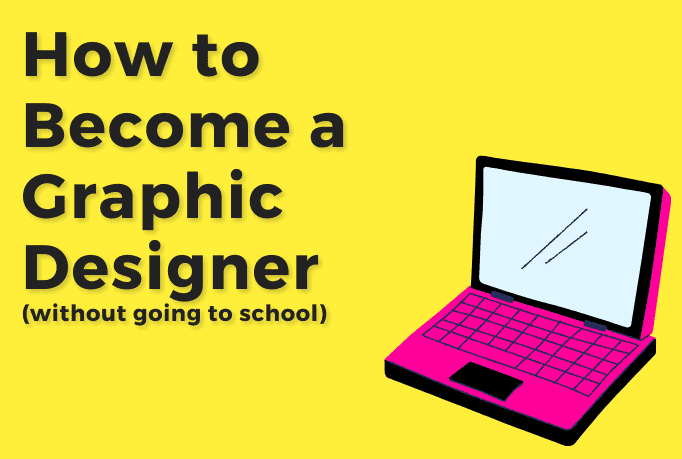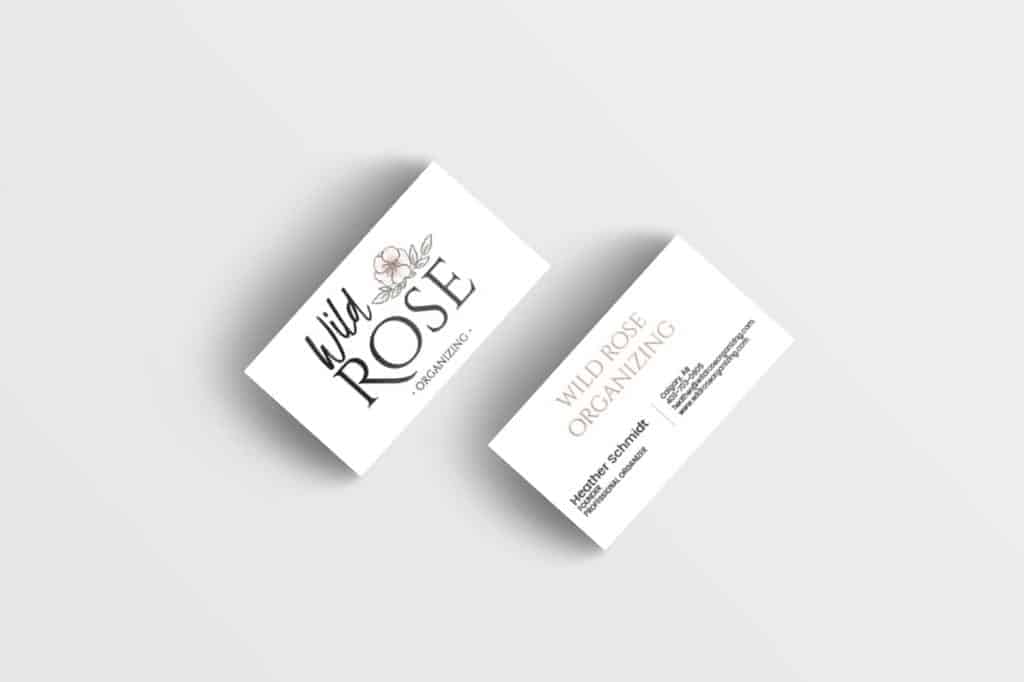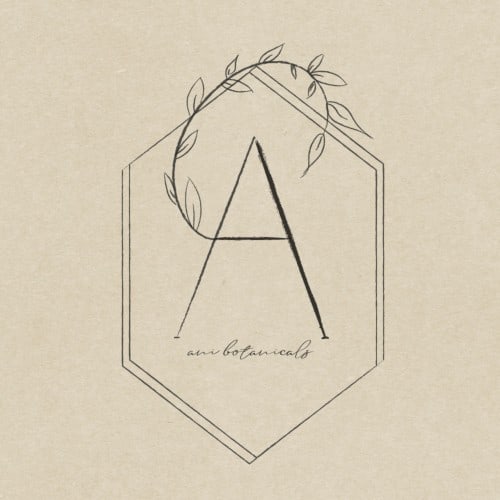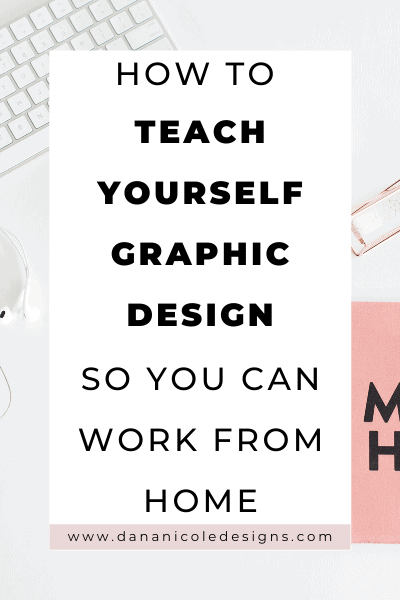Last Updated on

Learn graphic design online for free, without going to school or without a degree. If you would like to become a graphic designer, you can do so for free or by taking affordable and free courses. I taught myself graphic design and have helped many others learn to become designers through this article. Keep reading — you got this!
So you want to learn graphic design for beginners? You’re in the right spot! I’m going to teach you how I became a freelance graphic designer with zero experience and without holding a degree in graphic design.
For three years I worked as a freelance graphic/web designer, and while my career has taken a different path now, my graphic design experience was the catalyst to an online career and has helped me tremendously.
First, let me say that this article isn’t meant to undervalue those who do go to design school. Designers who spend years working on their craft are obviously very knowledgeable and do amazing work.
But sometimes school isn’t in the budget for everyone and you might want to learn graphic design on your own.
Figuring out how to learn graphic design is overwhelming, which is why I’ve written up all the steps I took for you to follow.
Second, this post by Karen Cheng helped me a lot when I was starting to learn graphic design. I recommend checking it out as well.
Now, let’s dive right into how to become a graphic designer!
This post contains affiliate links. When you click on a link within this post and make a purchase, I will earn a commission. This is at no additional cost to you.
Steps to Learn Graphic Design
Before you go any further, I want you to commit to yourself that you’re going to follow through with these steps (if it’s something you truly want to do)!
To give yourself a little reminder, Tweet the following and come back to it in several months time to see just how far you’ve come:
Today marks the day I begin a new path and teach myself graphic design #entrepreneur Share on XStep 1: Learn the Basics of Drawing
You don’t need to be a skilled drawer, but you will need to know some basics.
Before I began learning graphic design, I started with a good old pen and paper and went back to the basics.
I had to learn things like shadows and drawing 3D objects (something I wasn’t good at, but knew I would need to improve if I wanted to do logo design and mockups).
Could I draw freehand prior to teaching myself graphic design? Nope! So if Mark Kistler’s book You Can Draw in 30 Days: The Fun, Easy Way to Learn to Draw in One Month or Less can get my drawings to look good (and help me understand the principals of drawing), then it can do the same for you.
This resource is worth the investment (which is only a few cups of coffee).
I could have never hand-drawn the flower in the logo prior to reading this book:

This book doesn’t actually teach you how to become a graphic designer, but it teaches you the most important first steps when learning graphic design: the basics of art.
You learn all sorts of incredibly handy information, such as object shading and highlighting, how to give your designs more depth and structure, and different techniques that you won’t come across if you dive straight into learning Adobe Illustrator.
You might be asking “but what’s the big deal? Graphic design software has rulers and the ability to draw straight lines! So why would a drawing book help me if Illustrator already does all that for me?”
I had the same questions! Why should I learn how to draw if all I want to do is learn graphic design? What gives?!
Well, if you want to know how to become a graphic designer, learning to draw is important.
Illustrator (which is a program you’ll use to design your work) doesn’t tell you when your shadows are all in the wrong direction or when you have got the proportions all messed up.
And Illustrator also doesn’t tell you when you are trying to draw a face and the eyes are half the size they should be. But this book does. It helps you through it all.
I can’t tell you enough how important it is to learn basic drawing techniques first before you teach yourself graphic design.
You can also find many tutorials on YouTube to help you get started with drawing.
Step 2: Learn Graphic Design Theory
Your next step in learning graphic design is to learn some theory.
“But the theory is so boring.” I know, I know. Graphic design theory is rarely fun but I’m here to tell you how to become a graphic designer and the theory is super important.
If you want to become a graphic designer you’re going to need to learn some of the tedious material before jumping into the fun stuff.
Just because you are teaching yourself doesn’t mean you get to skip out on the boring material!
Knowing what types of fonts and colors go together and what doesn’t go together is going to help your designs immensely.
So teach yourself graphic design theory!
In regards to theory, I suggest starting off with learning the basics of color, typography, shape, space, lines, texture and size.

A great read to get you thinking of basic graphic design theory is the book Visual Grammar.
These books are some of my top picks for learning graphic design and design theory:
Step 3: Get Some Graphic Design Tools
As a bit of a digital nomad, my office moves around a lot so I like to keep it minimal when it comes to the tools I use. Luckily, graphic design doesn’t require lots of gadgets.
But the one thing you will need to become a graphic designer is graphic design software — this is non-negotiable 🙂
You can purchase Adobe Creative Cloud here which contains:
- Illustrator: will be used for logos and other vector-based graphics
- Photoshop: will be used to create special effects and edit media
- InDesign: will be used to create materials for print or online such as brochures, PDF’s, books etc.
Pro Tip: Before buying Adobe, reach out to their support team and ask for a better deal. I’ve done this and have known others who have, too. You can usually knock the price down for an annual plan which can bring your costs down quite a bit.
You can also get started with free Adobe alternatives like:
- GIMP (free Photoshop alternative)
- Inkscape (free Illustrator alternative)
- Scribus (free InDesign alternative)
Another tool I love to use is my Wacom Intuos Draw Tablet. It’s a very affordable piece of equipment that makes designing much easier and lets you have more control over your designs than when using a mouse.

I actually developed tendinitis in my finger from using my mouse so much, and my designs took much longer to create as I tried to draw with a mouse.
Now, I use my tablet for just about everything including hand-lettering, logo creation, masking in Photoshop.
However, when you’re first getting started, a mouse is good enough.
Step 4: Learn the Tools of Graphic Design
Now that you have the tools and the know the foundation of graphic design, it’s time to actually learn the tools (yes! You finally made it to the step where you are going to actually learn how to become a graphic designer that can make designs)!
I’m thankful for all the affordable and free online courses out there because they will save you months of time trying to piece everything together on your own.

Free Graphic Design Tutorials
I did a mix of paid and free courses when I first started out. There are plenty of paid courses you can find online that will get you up to speed (like this Udemy graphic design course).
However, you can also use YouTube tutorials to teach you everything if a course isn’t in the budget.
Here are some of my favorite YouTube channels that I leaned on when teaching myself graphic design include:
- Spoon Graphics: My favorite tutorial was the Tattoo Inspired Vector Illustration in Adobe Illustrator. Prior to buying a tablet, I searched high and low for some quick way to create stipple shading. So bookmark this tutorial for when you are ready to stipple shade.
- Design Tuts: There are some more advanced sports logo tutorials on this channel but it’s really helpful to see the process and how more advanced designs get formed.
- Will Patteson: His channel is full of great information. Everything from tutorials to Q&A’s about freelancing. This is my go-to channel and helped me so much as a beginner.
- Helen Bradley: This channel is my favorite for beginners. I came across Helen Bradley while searching how to make wreaths. Her tutorials are excellent for beginners.
- PHLEARN: This channel is strictly Photoshop. Verbal instructions make the tutorials easy to follow. Some other channels (not PHLEARN) have tutorials that don’t have verbal instruction and only have music playing, which can be frustrating for a beginner.
- Tasty Tuts: If you don’t want to read about graphic design theory, this channel offers video versions for you. I also learned InDesign by going through 15 InDesign lessons offered on this channel. Here is lesson one; the video description contains the other lessons.
- Skill Share: Videos on a range of creative topics.
- Matt Borchert: This video on Matt’s channel discusses designer ethics and is a must-watch.
- Graphic Tweakz: Logo tutorials galore!
- Satori Graphics: Tons of tutorials.
Keep in mind that I was basing my learning off of Adobe products, so many of the tutorials I used were geared towards tools like Illustrator and Photoshop. If you’re not using Adobe products, head to YouTube and search for tutorials for the tool you’re using. For example, Davies Media Design‘s channel has a few great GIMP tutorials!
Regardless, I recommend doing at least one new video per day so you can quickly build up a set of skills.
Step 5: Build Up Your Graphic Design Portfolio
My biggest worry, when I was becoming a graphic designer, was that nobody was going to want to work with me because I did not go to school for design.
This never ended up being an issue because of one thing that I unintentionally did.
I created a portfolio for myself as I was learning.
Create your own designs while you’re learning and put the best ones into a portfolio.
Next, l lot of people are scared to venture out into doing real work.
“What if they ask for my credentials or my degree?!” Maybe you’re scared of this too. Let me tell you something — I’ve never been asked once in my career for my credentials.
I have, however, been asked to see past work or a portfolio. Which is why it’s a good idea to get your portfolio started once you know what you’re doing.
So, where else can you find small projects to help develop your portfolio if you want to become a graphic designer?
There are lots of sites that allow graphic designers to pick up work. When I first started building my portfolio I found clients through friends and family, my local sub-Reddit, and 99designs.
I got a lot of graphic design practice through 99designs but I personally wouldn’t recommend it to make money, because you have to design for free and your designs only get chosen if the client likes it best out of the rest of the designs.
I don’t like advising anyone to work for free, but I did like that 99designs gives you a brief and lets you see how a real client process should look. In that respect, I found it useful.
You can also take on non-profits and let them know you are a design student who would like to get some real-life experience. Many non-profits don’t have a budget to hire designers so it’s a win-win for both of you.
FAQs About Learning Graphic Design
How Long Does it Take to Learn Graphic Design?
Realistically, it can take you a few months to learn to tools, but learning graphic design is truly a lifelong experience and is so much more than just knowing how to use the tools.
I spent a year learning graphic design (in my evenings) before I was confident enough to take on a client.
And even then, I’ve grown so much since then (as have my designs).
Is it Easy to Learn Graphic Design?
Becoming a graphic designer is a long learning process, and each step can take you anywhere from several weeks to several months.
But it is possible!
It’s all going to depend on how much time you want to put towards learning each element.
This guide should help you learn graphic design so that you can create digital designs and hopefully understand the science behind functional graphic design and branding.
As you get going, you’re going to find so many different areas to expand on and be familiar with before taking on clients such as:
- CMYK vs RGB
- vector vs raster
- bleeds and margins and how to properly set up documents for print
- other printing specs
There are also many different areas to specialize in and you may choose to veer towards a certain learning path that has its own set of rules and techniques to further learn.
For example, I think logo designers who specialize in hand-lettering and custom typography are incredible. It’s not something I’ve been able to master myself, but I love coming across some beautiful hand-lettered logos.
More Resources to Help You Learn Graphic Design
- Color Design Workbook: This book taught me everything I know about the psychology of color within design. I prefer to have this as a book so I can flip through it and reference it, and use it as a source of inspiration.
- Logo Type: Sometimes I sit down and just gawk at all the gorgeous designs within this book. It fills me up with so much inspiration.
- You Can Draw in 30 Days: The Fun, Easy Way to Learn to Draw in One Month or Less: I already mentioned this book above, but it was very instrumental in teaching me how to draw that I wanted to include it on this list again.
Next Steps After Learning Graphic Design
After you’ve learned graphic design, theory and all the tools, you are probably going to want to take on clients.
It’s important to do lots of research when designing logos and other branding collateral for your clients (if you choose to go down that route).
I’ve listed my entire graphic design process, including the questionnaires I use for client briefing, so you are able to understand the research you must do before you begin creating designs for clients.
Pin me:

This article may include affiliate links. As an Amazon Associate I earn from qualifying purchases.

Dana Nicole is an award-winning freelance writer for MarTech/SaaS who was rated one of the best SaaS writers by Software World. She specializes in writing engaging content that ranks high in search engines and has been featured in publications like Semrush, ConvertKit, and Hotjar.
Dana holds a Bachelor’s degree in Business Administration and has over 15 years of experience working alongside national brands in their marketing departments.
When Dana’s not working, you can find her dancing en pointe, cooking up new recipes, and exploring the great outdoors with her two big dogs.


Great Writing! This blog is really very informative. Thanks for sharing it with us.it also helpful for how digital marketing will be a change in this year.
I love these guidelines so much : And practice them for sure.
Hi.
Thanks so much for this. I’m currently working on steps 1 and 3.
What are some free softwares I can use on an Ipad if I’m not ready to purchase the Adobe Creative cloud?
Great Article & I love the book recommendations.
Thank you.
You’re welcome, Raygan!
These steps have had a good impact in my life, am now 20 and making the best of graphic design through this site. Thanks so much for this site.
I love hearing that, James!
so much helpful
Inadvertently clicked the link while on pinterest and i gotta say, it’s the best “mistake” I’ve made today. Thank you, Dana! It’s very insightful.
It was meant to be, Emmanuel! I’m glad you enjoyed the read 🙂
Super helpful article and so much info here. This is the best resource I have found and it clearly tells me how to “see what I don’t know” and then how to get it! Thank you so much.
You’re welcome! Best of luck on the path to teaching yourself graphic design!
Why am I seeing this now!
This is wonderful
What are your thoughts on beginning in Procreate, since it’s somewhat new?
I only worked with Adobe’s suite of products so I can’t comment, but I’ve heard Procreate is fantastic for handlettering and illustrations. Procreate doesn’t offer vector graphics though, unfortunately, and a lot of graphic design work requires vector files you can scale up or down.
However, if handlettering or illustration is the route you’d like to take (that doesn’t require vector files) you may want to consider Procreate. It looks like a very fun app to use 🙂
I ventured forth into the unknown today… and I would like to say YOUR IMPRESSIVE… this is all great. I am a teacher and hope to be able to teach myself something and help my teaching aids come along. THANKS so much!
I’m so happy to hear that Marichen! The internet opens the door to learning so many new skills. Best of luck!!
thanks so much for the confidence kick!
You’re welcome, Sarah!! You got this.
I never comment on blog posts but I wanted to say this is super helpful!! THANK you for taking the time to write this.
Thank you, Pleasant! I appreciate hearing that!
Same here. I never comment of posts, but this information is most impressive and incredibly appreciated. I’ve already ordered some of your suggestions and am looking forward to this new beginning! Thank you for the information and your time!
This makes me incredibly happy to hear! Thank you for taking the time to share your gratitude with me 🙂
You can add Satori Graphics to the list, one of my favourite channels on YouTube. I learned so much about design principles and so on
Great suggestion! They weren’t around when I was learning—I added them to the list for future designers.
I’m in the older age bracket and want to venture in a different direction. I’ve always had the hankering to paint, draw, and create design but never followed up as I really couldn’t draw exactly to proportion etc. Ideas are always there but putting it to paper was hopeless.
Your article is enlightening, stimulating and definitely enticing. I reckon I’ll commit for at least a year and in the process learn/consolidate by showing/practicing, and telling my 2 little grandchildren. Maybe in time help my adult children in their own businesses while enjoying the fun and pleasure from producing something appealing and creative? Thank you for your insight.
You sound like a wonderful role model for your children and grandchildren, Chrisella—showing them that it’s never too late to learn a new skill. In terms of drawing, I found there are plenty of useful tutorials on YouTube. I didn’t list them here, but if you search things like “drawing tutorials for beginners” on YouTube you’ll find a lot to follow along with 🙂 Best of luck!
Looking for another type of career, have always been drawing throughout my life, and it would be great to find bliss in my work life and make a good life for myself and my family.
Nice article! Thank you for reminding me what’s important in life…
For those who don’t know what the basics are let me mention this to help…
Find a school or place that teaches graphic design pick the one you like then print and/or copy the syllabus with the courses they teach. Most have the basics…follow it and you will have the training you need. Find the less expensive training somewhere else, but this list of courses will give you the road map you need. The only thing you won’t have is a piece of paper. Design your diploma! And people don’t care where you’ve been just what you can do for them hence the importance of a portfolio. Get her done!
Again, Thanks for your wisdom…
Your idea to follow a pre-defined syllabus is fantastic, Teri—love it! That feels like a lifehack that everyone should know.
Hi,
sorry, but I don’t think you can “learn” grafic design in a few months, when a real schooling takes years. And afterwards you’re still not a “finished” grafic designer. There is so much you learn by empirical knowledge over the years. What about the discussions and exchange with teachers/collegues/students, that will push you forwards and forces you to rethink your design until it is perfect? You can not “learn” that with any video tutorial, scrolling though pinterest and using adobe software…
Hi Melissa. Seems you didn’t read the entire article. Please see the section “How Long Does it Take to Learn Graphic Design?” I then go to say, “It can take you a few months to learn to tools, but learning graphic design is truly a lifelong experience and is so much more than just knowing how to use the tools.” In regards to your comment about speaking with teachers/collegues: you can do that online these days. There are plenty of FB groups, Reddit communities, and Discords for designers. I highly recommend people join communities to discuss design with their peers.
As I’ve said before, going to school is not an accessible OR affordable option for everyone. Not everybody lives in a country with free higher education. It’s a privileged and uninformed take to say that you can’t learn graphic design unless you enroll in school.
Great article it really inspired me after going through this wonderful article…. I’ll try all my possible best to be good in graphics design as you stated research is truly essential the theory might seem boring but indeed essential …thanks a lot
I love how organise you are in your writing. Easy to read. Helpful information for beginners who are wondering what is necessary to start digital design. I love it. Congrats for good article.
It was an amazing article. I was on search of someone who can answer me. Thank you .
Very educative article.lm starting my own blog very soon and from now on lm taking graphic design Seriously to part the things l will be doing on my blog. Thank you.
i’m in high spirits and so excited because when i read your article, i felt that i’m empathetic and that give me a lot of motivation to keep on studying Graphic Design. Honestly, sometimes i intend to quit this subject but now it doesn’t anymore. Thanks so much for a good article and hope you achieve great success in your life.
Hi Thanh, thank you for taking the time to comment! Wishing you all the best in pursuing graphic design!
Wow. That was great.
Congratulations on the article! Loved these youtube channel tips
Thank you so much…
It makes me feel so much motivated. I belongs to a middle class Indian family. I don’t want to do a 9 to 5 job. I want to do something which I can do for my whole life without getting bored.
Again thanks well written article.
Your words made me so happy, Pranjali! I wish you the best learning graphic design 🙂
Can we get those graphic design tools for free or we will have to invest?
You can search for free alternative. However, I don’t have experience with the free alternatives on the market so I’m not able to comment on them. But you can find reviews on Reddit to help you pick a tool that might work.
Thanks for recommending the Udemy graphic design course; it’s a fantastic resource for anyone looking to fast-track their learning.